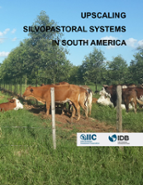Upscaling Silvopastoral Systems in South America
Date
Oct 2016
The world population is expected to increase from approximately 2.5 billion in 1950 to almost 10 billion in 2050, exhibiting the highest population growth rates in history. Securing the supply of wood and timber from sustainable sources without competing for agricultural land and food production has already become a challenge in many parts of the world.South America has had the advantage of being a large continent with a relatively small population, of which a large share lives in urban areas. Historically, these conditions have permitted inefficient land-use systems such as extensive livestock grazing for beef production. However, in recent decades export-oriented industrial agriculture has become the main driver of South American land use patterns, increasing the pressure for more efficient and intensive production systems.
Specialization and intensification in the land use sector have brought economic and productive benefits at a cost. They have caused the massive destruction of natural ecosystems while at the same time making national economies highly dependent on a reduced number of export products. Therefore opportunities for intensification on extensive grazing land and other inefficient land uses (often on marginal land) have to be considered. Particularly in times of pressing global environmental change and increasingly complex trade relationships, land use intensification has to take into account economic, environmental and social objectives and increase the resilience of the system as a whole.
Specialization and intensification in the land use sector have brought economic and productive benefits at a cost. They have caused the massive destruction of natural ecosystems while at the same time making national economies highly dependent on a reduced number of export products. Therefore opportunities for intensification on extensive grazing land and other inefficient land uses (often on marginal land) have to be considered. Particularly in times of pressing global environmental change and increasingly complex trade relationships, land use intensification has to take into account economic, environmental and social objectives and increase the resilience of the system as a whole.




